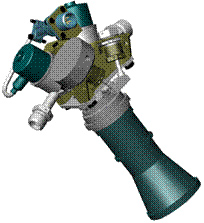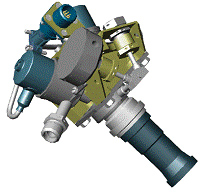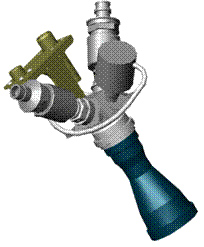THRUSTERS
Thrusters (LRE of small thrust) are intended for generation of steering forces in order to change attitude of space vehicles in orbit.
 |
 |
 |
thruster of 100 N |
thruster of 30 N |
thruster of 30 N |
Their advantages are:
• low mass and overall dimensions
• increased pressure tightness
• high response
• long service life
• high reliability
• operation in both continuous and pulse modes
• consumption of saturated and unsaturated propellants
• availability of pressure annunciator for telemetry control of the thruster operation.
Main technical characteristics
| Parameter |
Cyclone-3 LV thruster of 100 N |
Cyclone-3 LV thruster of 30 N |
Okean-O SC thruster of 30 N |
| Nominal thrust, N |
100 |
30 |
30 |
| Specific thrust at the continuous mode under the nominal inlet pressure, m/s |
2500 |
2300 |
2500 |
| Chamber pressure, MPa |
0.7 |
Propellants:
oxidizer
fuel |
NT
UDMH |
| Nominal inlet pressure, MPa |
1.35 |
| Nominal propellants mixture ratio |
1.61 |
1.27 |
1.6 |
| Guaranteed number of restarts |
1300 |
4900 |
Total firing time, s |
200 |
3600 |
| Supply voltage, V |
28 |
| Working temperature range, °C |
From 0 up to 35 |
| Single run duration, s |
From 0.21 to 165 |
From 0.21 to 600 |
| Mass, kg |
1.45 |
1.3 |
Experience gained during use of these thrusters in the Cyclone-3 launch vehicle and Okean-O spacecraft showed their high reliability and performance capabilities.
|

